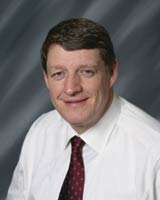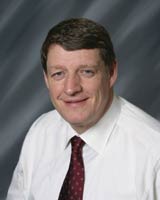
From the Top: Q & A with Chuck Gordon
 President and Chief Executive Officer Chuck Gordon offers his insight into Siemens Water Technologies. Previously he served as executive vice president of the Water & Wastewater Systems Group, and from 2003 - 2005 he served as president of the USFilter Water & Wastewater Services and Products Group. Gordon has been a member of the USFilter, now Siemens Water Technologies, management team since the acquisition of Arrowhead Industrial Water in May, 1995.
President and Chief Executive Officer Chuck Gordon offers his insight into Siemens Water Technologies. Previously he served as executive vice president of the Water & Wastewater Systems Group, and from 2003 - 2005 he served as president of the USFilter Water & Wastewater Services and Products Group. Gordon has been a member of the USFilter, now Siemens Water Technologies, management team since the acquisition of Arrowhead Industrial Water in May, 1995.
How did you get your start in this field? What is your background?
I have a bachelor of science degree from the University of South Dakota and a master's in business administration from Wake Forest University. I entered the water business via BF Goodrich in the mid-1980s, where I was part of a team that acquired Arrowhead Water in 1988. I moved over to Arrowhead where I became director of marketing and later held various other positions. From 1992 to 1995, I ran the business’s southern region, providing service contracts for industrial, mobile, and BOO (build-own-operate) clients.
When USFilter bought Arrowhead in 1995, I stayed with the company rather than with BF Goodrich. I became the regional manager for USFilter’s southern region. As part of USFilter’s dramatic growth over the next four years, I helped acquire about 17 businesses in the South. In 1999, USFilter was sold to Vivendi, and we nationalized our service organization. I became the vice president of our service organization from 2003-2005, and then the vice president of our systems organization from 2005 until I was appointed president and chief executive officer of Siemens Water Technologies in February 2008.
What is your company’s strength in the industry?
Siemens has several strengths. One important differentiating factor for Siemens Water Technologies is our company’s emphasis on research and development and innovation. We’ve invested significantly in the last several years. At the recent WEFTEC conference, we announced four new product lines, which reflect a greater emphasis on innovation -- specifically for sustainable solutions through new waste-to-energy technologies and developments in membrane bioreactor technologies for greater efficiency.
No other company has the breadth of technology and services along the complete water/wastewater treatment cycle that we do. Our advantage is the ability to combine various technologies and services into new, proprietary integrated solutions for customers. And with such a wide range of technologies and services to choose from, we are uniquely positioned to provide the optimum solution, which yields treatment systems that cost less to operate and require less space and energy.
An example is our Interchange Sequencing Batch Reactor (ISBR) system that combines our Omniflo® SBR with our Cannibal® solids reduction system. Such an ISBR system is helping a California casino’s wastewater treatment facility minimize solids wasting and use less than 10 percent of the power for solids treatment than was originally planned for.
Fast Facts about Siemens
According to the Web site, www.industry.siemens.com/water
• Worldwide Employees: 5,282
• Number of Installations: More than 200,000
• Locations Worldwide: 187
• Technologies/Service Offerings: More than 900
• R&D Locations: 12
• Patents & Trademarks: 1,888
• Product brands: Illinois Water Treatment, Envirex, Permutit, Stranco, Wallace & Tiernan, Zimpro, and Memcor
In August 2004, USFilter became part of the Siemens family of companies. The German-based world leader in engineering and automation purchased USFilter for $993 million and positioned it as the cornerstone for the new Siemens Water Technologies global business. USFilter has annual revenues in excess of $1 billion |
What are some of the opportunities you are pursuing -- expansion, R&D, new products or services?
Siemens’ presence in about 190 countries is allowing us to expand our global footprint. By using on-the-ground resources and through strategic acquisitions, we’ve expanded our technical and service offerings in key regions of the world. We’re also creating regional hubs of competency, or engineering centers, that allow us to support projects locally. China and Australia are stand-alone businesses that support those respective countries. The Southeast Asian and Indian markets are served through our Singapore hub. Next online will be the Middle East and Europe hubs. Our Latin American hub will be run from Brazil. North America, of course, is served through our water headquarters in Pennsylvania.
As mentioned, one of the ways we differentiate ourselves from our competitors is through R&D. We have created a global R&D center in Singapore, which focuses our worldwide technology development. Our prime areas for investment are solutions that reuse and recycle water, reduce energy consumption, manage biosolids, and reduce life-cycle costs of technology. As the population continues to grow and water demands rise, technologies that support these objectives will become even more critical.
An example of this innovation investment is the MemPulse™ MBR system. The device introduces air and mixed liquor into the bottom of the membrane modules through an “airlift effect” for increased scouring effectiveness, decreased operation and maintenance costs, and reduced energy consumption.
What are some of the challenges of the present economic situation?
Despite the global economy’s uncertainty, municipalities and industries still need to upgrade existing equipment to help reduce costs, better manage water resources, and comply with new regulations. When you look at the long-term drivers for the industry, there will continue to be a need for technologies and infrastructure for water treatment. So, even though the bond market and lending is sluggish, which may impact the market in the short term, we don’t see a long-term impact for the entire industry.
In the short term, there are solutions available to communities and industry such as installing mobile water treatment units or financing more permanent systems through Siemens Financial Services or similar avenues.
Overall, North America is an important, local market, but greater opportunity for market growth exists in other regions of the world – particularly, in Southeast Asia and India – where continued population growth and the need to increase infrastructure are key drivers.
Who do you consider your competitors?
In the $450-billion global water market, there are dozens and dozens of competitors, but only a few major global competitors. In the water treatment equipment segment, they are ITT, Veolia Water, GE Water, Andritz, and Kurita. None of their businesses have the scope of our technology offering into the water market, but we do compete with them in specific markets and technologies.
Then, there are the smaller, specialized companies like Huber, Ashbrook, Koch, Eimco, which we compete with on a product line or application basis. Other focused companies like Hyflux and Darco are competitive on a regional basis -- specifically Asia. There are literally hundreds of these types of companies in the water industry.
How is your company responding to the push for sustainability?
Through our R&D center in Singapore as well as through strategic licensing agreements, we’re launching new sustainable products. Much of our research and technology development focuses on water reuse technologies, energy reduction, and biosolids management.